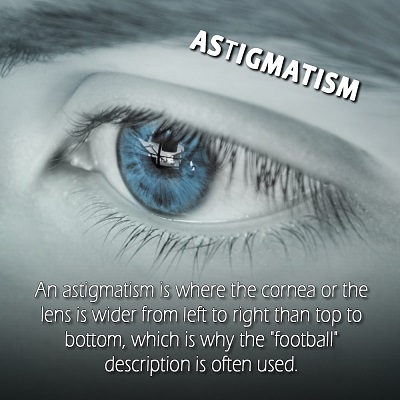 As one of the most common diagnoses given at an annual eye exam, it’s incredible how many people walk away with this new diagnosis and don’t really have a clue what it is, or how they got it.
As one of the most common diagnoses given at an annual eye exam, it’s incredible how many people walk away with this new diagnosis and don’t really have a clue what it is, or how they got it.
Even if your optometrist offered a clinical definition and assured you it’s nothing to worry about, you probably only remember “your eye is shaped like a football” and got stuck on the word astigmatism itself.
The funny thing is, your eye isn’t shaped like a football – it’s the lens. Let’s examine what astigmatism is, common signs and symptoms, how it’s diagnosed and how it’s treated.
Astigmatism Defined
The most basic explanation, and the go-to for optometrists, is the football analogy. This is easy for patients to understand, except they don’t get the whole picture. First, it’s not an eye disease; it’s an irregularity.
Light enters the eye through the cornea and eventually the light reaches the retina, which when sends signals to the brain to report on what you are actually seeing.
Astigmatism is when the light rays reach the retina at different points instead of a single point, which causes “refractive errors”.
In those with an astigmatism the cornea or lens has an abnormal shape, which is what causes the refractive errors. The cornea and lens should be symmetrical, like a circle. The measurements from top to bottom and left to right of the cornea and lens are the same length in a normal eye.
In someone with astigmatism, the cornea or the lens is wider from left to right than top to bottom, which is why the “football” description is often used.
Picture the face of a clock. Notice how the distance between 12 and 6 is the same as the distance between 9 and 3. This is not the case with an astigmatism.
To date, researchers haven’t isolated a cause and believe it may be genetic. Eye trauma has caused astigmatism in some patients, but the others are unexplained.
Astigmatism Symptoms
The list is short and other than an eye examination, an astigmatism could be left undetected. The symptoms include:
- Blurred vision
- Distorted or wavy vision
- Headaches from straining eyes
- Head or eye pain during or after reading or prolonged periods of looking at device screens, ie. computer, phone, tablet, etc.
- Squinting to see better
If there is pain or discomfort, it’s not the actual eye in pain. It’s the surrounding muscles trying to compensate for the visual distortion.
Oftentimes, those with an astigmatism will avoid reading books or spending a great deal of time in front of screens. They are trying to avoid the headaches that come along with those activities not realizing it’s an astigmatism and can be corrected.
How Astigmatism is Diagnosed
There are a few tools an optometrist may use during a comprehensive eye examination to diagnose an astigmatism. Visual acuity is tested by reading letters across the room with one eye covered at a time. Based on your score there you might then move on to keratometry which measures the curvature of the cornea.
If you’ve ever been measured for contact lenses, you’ve probably experienced keratometry. A corneal topographer creates a contour map of the cornea which gives even greater detail on the shape. And of course, there’s the phoropter which tests refraction. This is the series of lenses placed in front of your eyes and the optometrist says, “Which one is better? One? Or two?” while he is switching lenses back and forth.
All of these tests in combination give your optometrist a clear picture on a diagnosis of astigmatism, including the measurements needed for treatment.
How Astigmatism is Treated
Luckily, in most cases an astigmatism is treated the same as being nearsighted or farsighted. Glasses, contact lenses and refractive surgery (like LASIK) are all viable options depending on the degree of curvature to the cornea or lens.
When you choose glasses or even contacts, your eye care professional will take the axis measurements from the testing described above to determine the additional curvature of the corrective lenses you will be wearing.
Once upon a time, hard contact lenses were the only option if you wanted to get away from glasses – astigmatism or not. Now we can use soft lenses to correct nearsightedness, farsightedness and even astigmatism. The hard contact lenses are still available and used only for the more severe cases of astigmatism.
If you think you may have an astigmatism, please consult your eye doctor and make sure to keep up with your annual eye examinations. Your eye doctor will discuss the best options for your particular case and lifestyle needs.






